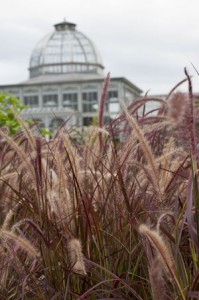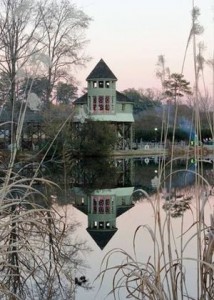Gardening: Ornamental Grass to the Rescue
by Lynn Kirk, Public Relations Writer, Lewis Ginter Botanical Garden, reprinted with permission from the Richmond Times-Dispatch

Traditional turf is a good choice for high-activity areas, but ornamental grass is a sustainable alternative elsewhere in the landscape. And it also changes throughout the year. Pictured is the seasonal change of eulalia grass. Photo by Don Williamson

The foreground shows purple fountain grass and in the distance you can see the Conservatory. The Conservatory lawn was recently planted with ornamental grasses: prairie dropseed, purple muhly grass and switchgrass. Photo by Don Williamson
Has your lawn set you up for what seems like a never-ending cycle of watering, mowing, fertilizing, aerating, reseeding, and then watering some more? If so, autumn is a good time to consider eco-friendly alternatives, including countless varieties of ornamental grasses. Unlike traditional turf, ornamental grass typically requires little to no watering once established. Deep roots, typically much longer than that of traditional turf, enable ornamental grass to better tolerate drought conditions. The longer roots also encourage infiltration of rainwater into the local water table, which helps improve water quality and reduces stormwater runoff.

Flowering perennials provide a nice complement to ornamental grasses, including this hardy dwarf fountain grass. Don Williamson
“Ornamental grasses may be a better choice than trees and shrubs in several conditions,” said Grace Chapman, director of horticulture at Lewis Ginter Botanical Garden. “The grasses like poor soils, such as our area’s clay-heavy soil, and they typically don’t need fertilizer.” Many varieties rated for zone 7 are hardy perennials, reducing or even eliminating the need for annual plantings. For property owners, this can equate to less maintenance and expense. Since mature grasses can be divided for propagation of more plants, gardens also can be expanded without additional costs. Wildlife welcomes the switch from turf to ornamental grass. While birds rely on the grasses for food, thick clumps of growth provide cover, shelter and nesting sites, encouraging a more robust local ecosystem. Beyond practical reasons, there are aesthetic bonuses for incorporating ornamental grasses in the landscape: Their beauty provides ever-changing visual interest through all four seasons. With warm-season grasses, new growth appears in spring, stalks and plumes serve as focal points in summer and changing colors announce autumn. And unlike turf, at the end of the year, their texture and form provide structure in winter’s bare-bones landscape. Even with Richmond’s formal architecture and landscapes, ornamental grasses can find a home.
“They can be very structured and classic or more naturalistic for a meadow effect,” Chapman said. “There are so many varieties to choose from, so do your homework to achieve the effect you want.”

Many ornamental grasses, like this sedge, acknowledge autumn with eye-catching hues. Photo by
Don Williamson
Selections can range from cool- to warm-season growth habits, sunny to shade loving, dry to wet preferences, solid hued to variegated foliages, and upright to arching forms. Design flexibility also stems from varying heights at maturity, ranging from low-growing grasses for groundcovers to tall grasses for screens and backdrops. Most ornamental grasses are striking additions, whether planted in large expanses or mixed with annuals and other perennials.
“They can even be prominently positioned as an exclamation point in the landscape,” Chapman said. “Ornamental grasses add a completely different element to the environment, and they’re enchanting as they blow in the breeze.”

Ornamental grasses grow near the water at Lewis Ginter Botanical Garden, with the Tree House reflected in the background. Photo by Lucky Ginger Studio
Sampling of Zone 7 Ornamental Grasses
Low height: Flame grass, prairie dropseed, ribbon grass, sedge
Dwarf varieties, medium height: Blue oatgrass, blue fescue, feather reedgrass, little bluestem, muhly grass, purple love grass, switchgrass, zebragrass
Tall height: big bluestem, fountain grass, maiden grass, pampas grass, ravennagrass,
Editor’s Note: This article first published in the Richmond Times-Dispatch, in October 2014.
